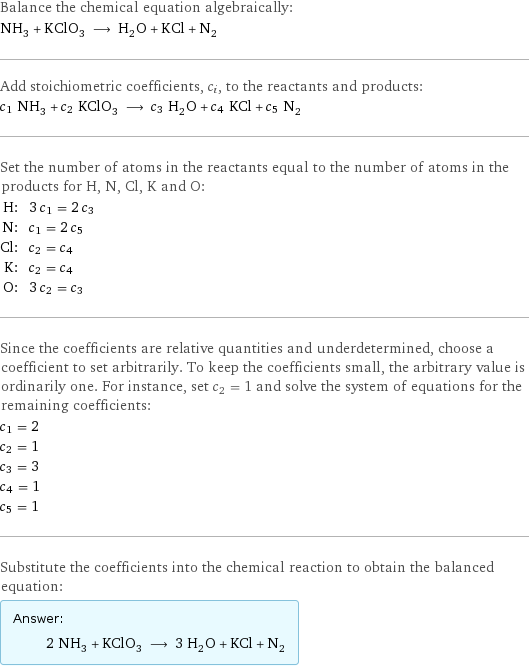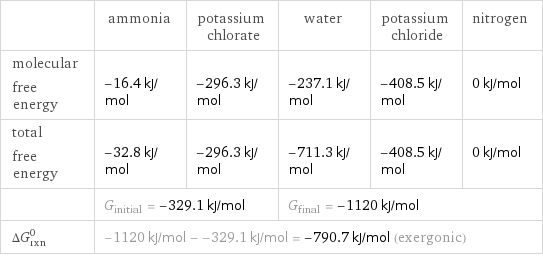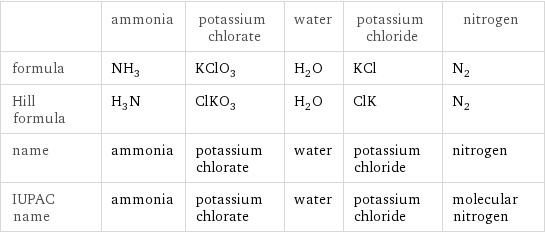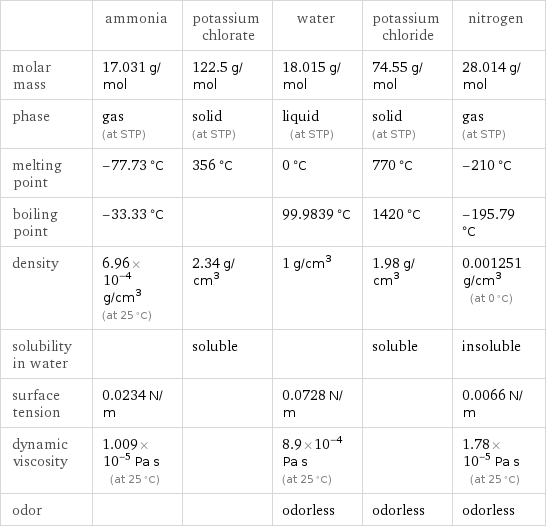Input interpretation

NH_3 ammonia + KClO_3 potassium chlorate ⟶ H_2O water + KCl potassium chloride + N_2 nitrogen
Balanced equation

Balance the chemical equation algebraically: NH_3 + KClO_3 ⟶ H_2O + KCl + N_2 Add stoichiometric coefficients, c_i, to the reactants and products: c_1 NH_3 + c_2 KClO_3 ⟶ c_3 H_2O + c_4 KCl + c_5 N_2 Set the number of atoms in the reactants equal to the number of atoms in the products for H, N, Cl, K and O: H: | 3 c_1 = 2 c_3 N: | c_1 = 2 c_5 Cl: | c_2 = c_4 K: | c_2 = c_4 O: | 3 c_2 = c_3 Since the coefficients are relative quantities and underdetermined, choose a coefficient to set arbitrarily. To keep the coefficients small, the arbitrary value is ordinarily one. For instance, set c_2 = 1 and solve the system of equations for the remaining coefficients: c_1 = 2 c_2 = 1 c_3 = 3 c_4 = 1 c_5 = 1 Substitute the coefficients into the chemical reaction to obtain the balanced equation: Answer: | | 2 NH_3 + KClO_3 ⟶ 3 H_2O + KCl + N_2
Structures

+ ⟶ + +
Names

ammonia + potassium chlorate ⟶ water + potassium chloride + nitrogen
Reaction thermodynamics
Enthalpy

| ammonia | potassium chlorate | water | potassium chloride | nitrogen molecular enthalpy | -45.9 kJ/mol | -397.7 kJ/mol | -285.8 kJ/mol | -436.5 kJ/mol | 0 kJ/mol total enthalpy | -91.8 kJ/mol | -397.7 kJ/mol | -857.5 kJ/mol | -436.5 kJ/mol | 0 kJ/mol | H_initial = -489.5 kJ/mol | | H_final = -1294 kJ/mol | | ΔH_rxn^0 | -1294 kJ/mol - -489.5 kJ/mol = -804.5 kJ/mol (exothermic) | | | |
Gibbs free energy

| ammonia | potassium chlorate | water | potassium chloride | nitrogen molecular free energy | -16.4 kJ/mol | -296.3 kJ/mol | -237.1 kJ/mol | -408.5 kJ/mol | 0 kJ/mol total free energy | -32.8 kJ/mol | -296.3 kJ/mol | -711.3 kJ/mol | -408.5 kJ/mol | 0 kJ/mol | G_initial = -329.1 kJ/mol | | G_final = -1120 kJ/mol | | ΔG_rxn^0 | -1120 kJ/mol - -329.1 kJ/mol = -790.7 kJ/mol (exergonic) | | | |
Entropy

| ammonia | potassium chlorate | water | potassium chloride | nitrogen molecular entropy | 193 J/(mol K) | 143 J/(mol K) | 69.91 J/(mol K) | 83 J/(mol K) | 192 J/(mol K) total entropy | 386 J/(mol K) | 143 J/(mol K) | 209.7 J/(mol K) | 83 J/(mol K) | 192 J/(mol K) | S_initial = 529 J/(mol K) | | S_final = 484.7 J/(mol K) | | ΔS_rxn^0 | 484.7 J/(mol K) - 529 J/(mol K) = -44.27 J/(mol K) (exoentropic) | | | |
Equilibrium constant
![Construct the equilibrium constant, K, expression for: NH_3 + KClO_3 ⟶ H_2O + KCl + N_2 Plan: • Balance the chemical equation. • Determine the stoichiometric numbers. • Assemble the activity expression for each chemical species. • Use the activity expressions to build the equilibrium constant expression. Write the balanced chemical equation: 2 NH_3 + KClO_3 ⟶ 3 H_2O + KCl + N_2 Assign stoichiometric numbers, ν_i, using the stoichiometric coefficients, c_i, from the balanced chemical equation in the following manner: ν_i = -c_i for reactants and ν_i = c_i for products: chemical species | c_i | ν_i NH_3 | 2 | -2 KClO_3 | 1 | -1 H_2O | 3 | 3 KCl | 1 | 1 N_2 | 1 | 1 Assemble the activity expressions accounting for the state of matter and ν_i: chemical species | c_i | ν_i | activity expression NH_3 | 2 | -2 | ([NH3])^(-2) KClO_3 | 1 | -1 | ([KClO3])^(-1) H_2O | 3 | 3 | ([H2O])^3 KCl | 1 | 1 | [KCl] N_2 | 1 | 1 | [N2] The equilibrium constant symbol in the concentration basis is: K_c Mulitply the activity expressions to arrive at the K_c expression: Answer: | | K_c = ([NH3])^(-2) ([KClO3])^(-1) ([H2O])^3 [KCl] [N2] = (([H2O])^3 [KCl] [N2])/(([NH3])^2 [KClO3])](../image_source/34fa8beb00e2ca37c0a48f732962cb1c.png)
Construct the equilibrium constant, K, expression for: NH_3 + KClO_3 ⟶ H_2O + KCl + N_2 Plan: • Balance the chemical equation. • Determine the stoichiometric numbers. • Assemble the activity expression for each chemical species. • Use the activity expressions to build the equilibrium constant expression. Write the balanced chemical equation: 2 NH_3 + KClO_3 ⟶ 3 H_2O + KCl + N_2 Assign stoichiometric numbers, ν_i, using the stoichiometric coefficients, c_i, from the balanced chemical equation in the following manner: ν_i = -c_i for reactants and ν_i = c_i for products: chemical species | c_i | ν_i NH_3 | 2 | -2 KClO_3 | 1 | -1 H_2O | 3 | 3 KCl | 1 | 1 N_2 | 1 | 1 Assemble the activity expressions accounting for the state of matter and ν_i: chemical species | c_i | ν_i | activity expression NH_3 | 2 | -2 | ([NH3])^(-2) KClO_3 | 1 | -1 | ([KClO3])^(-1) H_2O | 3 | 3 | ([H2O])^3 KCl | 1 | 1 | [KCl] N_2 | 1 | 1 | [N2] The equilibrium constant symbol in the concentration basis is: K_c Mulitply the activity expressions to arrive at the K_c expression: Answer: | | K_c = ([NH3])^(-2) ([KClO3])^(-1) ([H2O])^3 [KCl] [N2] = (([H2O])^3 [KCl] [N2])/(([NH3])^2 [KClO3])
Rate of reaction
![Construct the rate of reaction expression for: NH_3 + KClO_3 ⟶ H_2O + KCl + N_2 Plan: • Balance the chemical equation. • Determine the stoichiometric numbers. • Assemble the rate term for each chemical species. • Write the rate of reaction expression. Write the balanced chemical equation: 2 NH_3 + KClO_3 ⟶ 3 H_2O + KCl + N_2 Assign stoichiometric numbers, ν_i, using the stoichiometric coefficients, c_i, from the balanced chemical equation in the following manner: ν_i = -c_i for reactants and ν_i = c_i for products: chemical species | c_i | ν_i NH_3 | 2 | -2 KClO_3 | 1 | -1 H_2O | 3 | 3 KCl | 1 | 1 N_2 | 1 | 1 The rate term for each chemical species, B_i, is 1/ν_i(Δ[B_i])/(Δt) where [B_i] is the amount concentration and t is time: chemical species | c_i | ν_i | rate term NH_3 | 2 | -2 | -1/2 (Δ[NH3])/(Δt) KClO_3 | 1 | -1 | -(Δ[KClO3])/(Δt) H_2O | 3 | 3 | 1/3 (Δ[H2O])/(Δt) KCl | 1 | 1 | (Δ[KCl])/(Δt) N_2 | 1 | 1 | (Δ[N2])/(Δt) (for infinitesimal rate of change, replace Δ with d) Set the rate terms equal to each other to arrive at the rate expression: Answer: | | rate = -1/2 (Δ[NH3])/(Δt) = -(Δ[KClO3])/(Δt) = 1/3 (Δ[H2O])/(Δt) = (Δ[KCl])/(Δt) = (Δ[N2])/(Δt) (assuming constant volume and no accumulation of intermediates or side products)](../image_source/d51add4438d918295eb1527205916d3a.png)
Construct the rate of reaction expression for: NH_3 + KClO_3 ⟶ H_2O + KCl + N_2 Plan: • Balance the chemical equation. • Determine the stoichiometric numbers. • Assemble the rate term for each chemical species. • Write the rate of reaction expression. Write the balanced chemical equation: 2 NH_3 + KClO_3 ⟶ 3 H_2O + KCl + N_2 Assign stoichiometric numbers, ν_i, using the stoichiometric coefficients, c_i, from the balanced chemical equation in the following manner: ν_i = -c_i for reactants and ν_i = c_i for products: chemical species | c_i | ν_i NH_3 | 2 | -2 KClO_3 | 1 | -1 H_2O | 3 | 3 KCl | 1 | 1 N_2 | 1 | 1 The rate term for each chemical species, B_i, is 1/ν_i(Δ[B_i])/(Δt) where [B_i] is the amount concentration and t is time: chemical species | c_i | ν_i | rate term NH_3 | 2 | -2 | -1/2 (Δ[NH3])/(Δt) KClO_3 | 1 | -1 | -(Δ[KClO3])/(Δt) H_2O | 3 | 3 | 1/3 (Δ[H2O])/(Δt) KCl | 1 | 1 | (Δ[KCl])/(Δt) N_2 | 1 | 1 | (Δ[N2])/(Δt) (for infinitesimal rate of change, replace Δ with d) Set the rate terms equal to each other to arrive at the rate expression: Answer: | | rate = -1/2 (Δ[NH3])/(Δt) = -(Δ[KClO3])/(Δt) = 1/3 (Δ[H2O])/(Δt) = (Δ[KCl])/(Δt) = (Δ[N2])/(Δt) (assuming constant volume and no accumulation of intermediates or side products)
Chemical names and formulas

| ammonia | potassium chlorate | water | potassium chloride | nitrogen formula | NH_3 | KClO_3 | H_2O | KCl | N_2 Hill formula | H_3N | ClKO_3 | H_2O | ClK | N_2 name | ammonia | potassium chlorate | water | potassium chloride | nitrogen IUPAC name | ammonia | potassium chlorate | water | potassium chloride | molecular nitrogen
Substance properties

| ammonia | potassium chlorate | water | potassium chloride | nitrogen molar mass | 17.031 g/mol | 122.5 g/mol | 18.015 g/mol | 74.55 g/mol | 28.014 g/mol phase | gas (at STP) | solid (at STP) | liquid (at STP) | solid (at STP) | gas (at STP) melting point | -77.73 °C | 356 °C | 0 °C | 770 °C | -210 °C boiling point | -33.33 °C | | 99.9839 °C | 1420 °C | -195.79 °C density | 6.96×10^-4 g/cm^3 (at 25 °C) | 2.34 g/cm^3 | 1 g/cm^3 | 1.98 g/cm^3 | 0.001251 g/cm^3 (at 0 °C) solubility in water | | soluble | | soluble | insoluble surface tension | 0.0234 N/m | | 0.0728 N/m | | 0.0066 N/m dynamic viscosity | 1.009×10^-5 Pa s (at 25 °C) | | 8.9×10^-4 Pa s (at 25 °C) | | 1.78×10^-5 Pa s (at 25 °C) odor | | | odorless | odorless | odorless
Units
